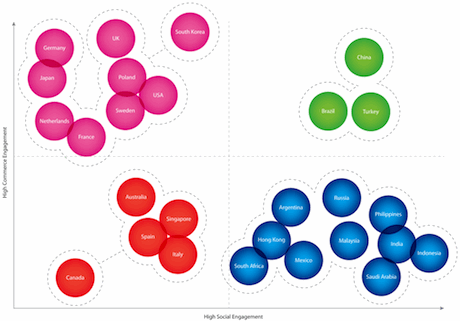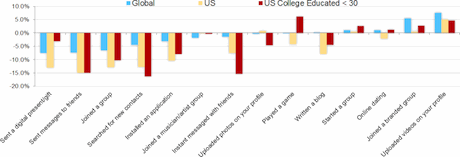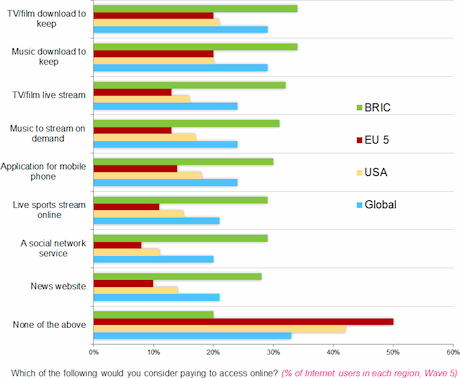Internet Trends: Social Media Fatigue, Real-Time, Mobile and TV Content Grow
Chinwag's Sam Michel recently wrote about survey results claiming early adopters were growing weary of social media and when we spotted similar results in the recent wave of results from GlobalWebIndex from our friends at Trendstream, we asked for more detail.
And they didn't disappoint, here's a round-up of the five key trends from the 5th wave of their research. This analysis of key changes in behaviour is based on interviews with early 100,000 individuals in 27 key internet markets (full presentation is embedded below).
Trend 1: The Fragmented Web
The way that we use the web is increasingly varied. The global internet has become a mix of local internets, each with radically different adoption levels and behaviour profiles. Although the broad global trend is the growth of social and entertainment platforms, this varies heavily by market.
The gap between the fastest and the slowest-growing markets for platforms such as Instant Messenger and Social Networking can be as much as 73%, for example.
Broadly, emerging markets are driving the uptake of social channels, while consumers in more mature markets focus on purchasing and e-commerce. Ultimately global web use is coalescing into four distinct clusters differing by their mix of engagement with social channels and commerce.
Trend 2: Welcome to the Post-PC world
One factor that’s encouraging the fragmentation of the web is the changing way we access the internet. PCs and laptops are being replaced by mobile and other devices such as tablets and TV as the favourite go-to device for connection. The internet is becoming packaged into a series of distinct experiences for a wide range of platforms.
Apps and device-specific platforms help create a diverse and disconnected web; app usage is growing across all categories, by as much as 19% between February 2011 and June 2011 for gaming apps alone. The number of consumers with smartphones who have downloaded a mobile app in the last month has increased from 14%, to 24% in North America, from 16% to 24% in Europe, 29% to 42% in Asia Pacific and 19% to 26% in Latin America since Wave 1 in July 2009.
Consumers also expect their web access routes to change further in the next 12 months. Although 79% now cite their personal PC/laptop as their favourite internet device, in 12 months only 42% as consumers switch to tablet devices (19%), mobile (18%), Work PC/laptop (11%) and TV (7%) and Ebooks (3%).
In the five biggest EU markets – Germany, France, UK, Italy, Spain – mobile internet usage is growing significantly faster than its PC counterpart. For example the number of consumers who have read news via the mobile internet is up 133%, while this has declined via PC, accessed their social profile is up 176%, compared to 29% via PC or searched for local services/places is up 123%, for example.
In BRIC markets, penetration of mobile internet activities is already approaching the level of PC and Laptops, although both types of connection are seeing strong growth as the number of internet users increases.
Trend 3: Continued Rise of Real-Time
Microblogging and social networking are the fastest growing social media activities, up 62% and 40% from Wave 1 (July 2009) to Wave 5 (June 2011) respectively. Social platforms that can be accessed and updated via mobile platforms are growing fast while those requiring more considered input such as blogging are stagnant or in decline.
The level of content creation has dropped as real-time platforms encourage sharing of others content. The more consumers use microblogging platforms, the more likely they are to link to another micro-blog, send a link to a video, link to a news story or images.

However growth rates for social media are not uniform. Just under 40% of internet users in BRIC countries have used a microblogging platform in the last month compared to 23.1% globally and 6.6% in the US. In English-speaking markets, usage of microblogging platforms such as Twitter and location-based services is stagnating.
Trend 4: Facebook Fatigue
Time has wearied users of Facebook. Total usage of the platform is growing thanks to emerging markets but established markets such as the US, UK and Canada have seen large declines in terms of active participation such as status updates, sharing content, messaging and installing applications.
Active behaviour in the US such as message friends and joined a group in the last month, for example are down 15% points and 10% respectively since the start of the research project. This trend is even-more pronounced among US college educated, twenty-somethings, the original users of the platform.
Globally, however, total active usage of all social network sites has risen dramatically globally in all age groups, up 26% among 16-24s, 46% among 25-34s, 35% among 35-44s and by 52% among 45-54s between Wave 1 and Wave 5.
Trend 5: The Lean-Back Internet
The rise of the real-time web is highlighting the value of traditional content. As consumers have switched from being content creators to transmitters of information, so demand for news, video content, films, TV and sports as exploded.
Consumers are more willing to pay for content or services, however, this propensity to pay differs strongly by market.
It is strongest and growing in BRIC markets, while the five biggest EU markets are the least willing to pay for services such as study materials, ebooks, music downloads, mobile app, dating or games.
More than half of internet users in Germany, France, UK, Italy and Spain would not consider paying for online content, although they were more willing to pay for items such as web services such as email and cloud storage.
Photo (cc) James Chen. Research and graphs (c) Trendstream.





